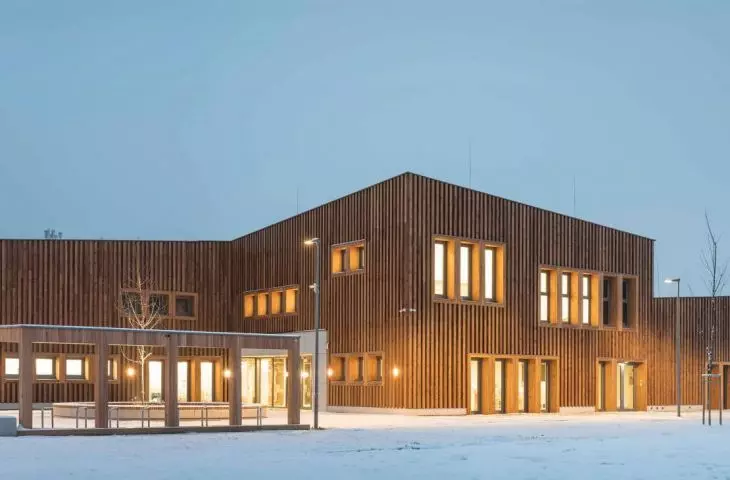Four years ago, the Silesian studio M.O.C. Architekci won a competition organized by the Municipality of Michałowice and SARP Warsaw. The task the architects faced in the first, study phase was to develop the development of the planned educational campus in Reguły. In turn, the goal of the second, implementation phase of the competition was to prepare a design for a kindergarten building. On whether the completed building is consistent with the competition concept, we talk to Ewa Janik, an architect from the M.O.C. Architekci office.
Six modules on a square plan surround the central module, the heart of the establishment — a patio with a tree, which can be viewed through large glazing in the corridor. The individual blocks, although planned on a similar plan, differ in height and shape of the canopy, so that grouped together they do not overwhelm. The rhythm of the wooden boards on the facade is broken by irregularly placed windows of different shapes and sizes.
first floor plan and cross-section of the kindergarten
© M.O.C. Architekci
Ola Kloc: In 2019 your project for an educational campus and kindergarten at the Michałowice Municipality Office in Reguły won the competition, today it is completed — how has the project evolved over this time? Has anything changed from the original ideas?
Ewa Janik: The project has not changed significantly since the competition, which means that we have managed to meet almost all the expectations of the ordering party, which we are very pleased with. The form and functional layout are similar to what was presented in the competition phase. Only the construction of the facade has changed. During the design work, we decided to design the wooden facade in a spatial form, rather than flat, thanks to which an interesting chiaroscuro appeared on it, giving depth to the facade.
the rhythm of wooden planks on the facade is broken by irregularly placed windows of different shapes and sizes
Photo: Juliusz Sokołowski | Illustrations courtesy of M.O.C. Architekci
Ola: The building was intended to be energy efficient and pro-environmental — what solutions make this possible?
Ewa: The project proposed many energy-efficient and pro-environmental solutions at the level of simple, generally available technological solutions.
An underground rainwater storage tank was created next to the building. Rainwater is discharged into a retention tank, and then used to water the greenery in the kindergarten area. The partitions of the building were insulated using insulating materials with very high insulation properties, which allows energy savings.
the architects decided to make the facade in a spatial form, rather than flat, so they obtained an interesting chiaroscuro
Photo: Juliusz Sokołowski | Illustrations courtesy of M.O.C. Architekci
Ola: There is a lot of talk these days about the impact of school architecture on the development of students, what issues did you have in mind when creating this facility?
Ewa: The external form and technical equipment of the building are important factors in shaping the aesthetic sensitivity and ecological culture of children. Hence, we used wood as the main material on the facades and interior of the facility, which gives a friendly and natural character to the building, which is extremely important for young children. The wooden finish gives a high level of comfort in perception and provides users with a high aesthetic experience. The use of wood on the facade, with its sustainable sourcing, is a responsible and beneficial alternative to today's modern building materials. In this way, the building, combined with the surrounding green nursery garden, fits perfectly into the natural environment. It was also important to us to create bright, airy spaces, hence each of the teaching rooms, which are up to 4.5 meters high, is illuminated through large windows with direct access to the garden. A patio has been created at the heart of the building, with a layout of spacious corridors surrounding it. Both the patio and the corridors provide additional space for children's education and play.
the heart of the establishment is the inner patio
Photo: Juliusz Sokołowski | Illustrations courtesy of M.O.C. Architekci
view from the corridor to the patio
Photo: Juliusz Sokołowski | Illustrations courtesy of M.O.C. Architekci
Ola: Your proposal was selected through a competition — from the perspective of an architectural studio, how do you evaluate the whole process, from first stage to implementation?
Ewa: We are pleased that such an investment was developed on the basis of an architectural competition. We positively evaluate the cooperation with the investor due to the constant contact and willingness to cooperate. However, we have to admit that the short deadline for the project was disproportionate to the time needed for the official and tender procedures.
The competition was a two-stage competition, where in the first stage the task was the urban solution of the entire educational campus, of which the kindergarten according to our design is the first completed building. We were upset that the investor, the Municipality of Michałowice, abandoned the form of the competition to select the designers of subsequent buildings and settled in early July of this year a tender for the design documentation of the elementary school building.
interior of the hall
Photo: Juliusz Sokołowski | Illustrations courtesy of M.O.C. Architekci
Ola: Thank you for the interview.











































































